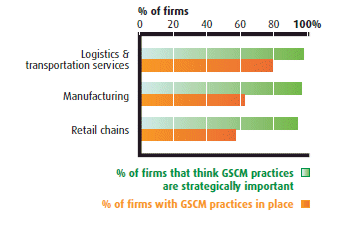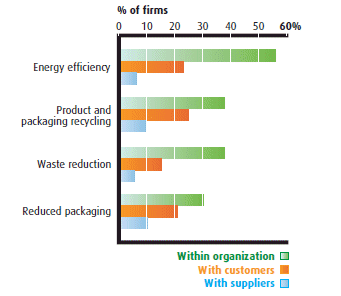GSCM Practices: Drivers and Adoption
Canadian logistics and transportation service providers view high cost of energy as the main driver for implementing GSCM practices due to these firms' high reliance on energy in their operations (Figure 1) — energy costs can amount to 55 percent of air transportationcosts and 29 percent of truck transportation costs.33 Otherdrivers that Canadian logistics and transportation service providers view as important include developingcompetitive advantages, becoming a leader in sustainability, and access to foreign markets.1 To make GSCMinitiatives successful in the logistics and transportation service industry, environmental benefits and positive NetPresent Value (NPV) for the service provider must both be achieved at the same time.2
Figure 1: Main drivers for implementing GSCM practices in distribution activities 1

Most logistics and transportation service providers and their supply chain partners believe that GSCM practices are strategically important (Figure 2). Since logistics andtransportation service providers own more transportation assets than manufacturing and retail businesses,they have additional options and opportunities to implement GSCM practices.2 For this reason, a higher percentage (80 percent) of logistics and transportation service providers are implementing GSCM practices in distribution activities compared with manufacturing firms and retail chains.1
Figure 2: Perspectives on and use of GSCM practices in distribution activities1

GSCM practices can be applied at different points in the supply chain, either within the organization or in collaboration with customers and suppliers. Canadian logistics and transportation service providers primarily engage in these practices within their organization. Specifically, energy efficient distribution activities constitute the most common GSCM practice, with 55 percent of businessesimplementing them in–house, followed by product and packaging recycling and waste reduction (Figure 3). Fewer logistics and transportation service providers are engaging in GSCM practices with their supply chain partners — only 25 percent with customers (due in part toretail chain GSCM mandates) and less than 10 percent with suppliers.
Figure 3: Main GSCM practices implemented in distribution activities1

